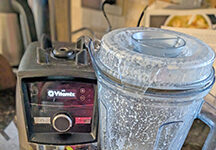Amanda Miller
Columnist
Lettuce Eat Local
“Big Z, little z, what begins with Z?” I knew Dr. Seuss and I would follow the same queries in our alphabet journey, although our answers would always be different. While my ABCs might not have been everyone’s piece of cake, at any rate mine didn’t result in things like Silly Sammy Slick sipping his six sodas and getting sick sick sick. (Well, at least I didn’t hear that any of you suffered illness after trying my recipes….)
I could have borrowed a page from Jerry Jordan’s jelly jar and jam beginning with J, and Benson wouldn’t have minded if we followed David Donald Doo and dreamed up a dozen doughnuts, even if they came with a duck-dog too. I often feel like Young Yolanda Yorgenson, wondering if the chaos level would actually be less if I were merely yelling on the back of a yawning yellow yak.
But I don’t need to make up characters like the Zizzer-Zazzer-Zuzz for my Z — although at first glance you might think I am. Zucchini would have been the obvious choice here, but you know me. We’re going with Za’atar instead! You can say it “zah-tar,” and a more authentic pronunciation would put the emphasis on the first syllable, and give that r a little roll.
What is it, though? That’s a two-fold answer, as za’atar is both a Middle Eastern spice blend and an herb traditionally contained within that blend. The plant itself, also known as hyssop or Syrian oregano, has flavors similar to thyme and oregano, so in commercial blends on this side of the Atlantic they typically stand in its stead.
Ironic, right; most za’atar does not contain za’atar. To be fair, I just wrote about wasabi that rarely ever has wasabi in it; and have you ever had popcorn shrimp with even a single piece of popcorn? Oh wait, that’s different.
Anyway, in addition to the dried herbs, za’atar also contains sesame seeds and sumac (a tart, lemony spice ground from dried red sumac berries). The ingredient list might stop there, or have a few more regional or personal additions, like marjoram, dill, or even orange zest. It’s often paired with meats, hummus, labneh, salads, and flatbreads.
While za’atar isn’t very common in these parts, it is possible to seek and find it even here in central Kansas; I have at least two different blends in my cupboard. That said, it’s likely easier to just make your own mix — which, incidentally, I’ll be sharing with you as this week’s recipe.
But making za’atar does no good if you don’t know how to use it. Even though I have a couple jars of it and love the flavor, I have to admit that I rarely ever eat it. Zucchini is by far and away the more common Z in my cookbook indices. While I clearly don’t stick to following recipes, I ordinarily look at one/some and go from there; so if za’atar isn’t mentioned, I often forget it. If I’m just looking for “something something” as I spin my spice cabinet shelves, there are scores of other blends to catch my eye (baharat, tandoori, berbere…and so forth and so on). And I just realized my za’atar is on an inside row since it’s in a big jar, meaning I don’t see it as quickly.
So I need to do some rearranging, because I do love za’atar and need to remember to use it. And it doesn’t even require a zizzer-zazzer-zuzz, so that should help.
Homemade Za’atar
Za’atar is from the South West Asia and North Africa region, so it pairs well with flavors and dishes from those countries, but it could turn into your new favorite all-around seasoning. Herby, lemony, nutty…it’s got it all. There’s even an International Za’atar Day on September 23, so start practicing now incorporating it into your table. Adding it to a Super Bowl appetizer this weekend would be a perfect start.
Prep tips: Remember this is a blend that you can personalize, so try this basic equal-parts ratio, but adjust to your preferences. If you can’t find sumac, try drying and crushing some lemon zest and using that instead.
1 tablespoon dried thyme
1 tablespoon dried oregano
1 tablespoon sumac
1 tablespoon toasted sesame seeds
Mix all ingredients. Most blends don’t include salt, but to increase the ease of using as a sprinkle-on-anything seasoning, you can add a teaspoon of coarse salt. Use liberally.



